Tags
Perhaps it is Wat Lok Molee’s location, across the moat from the Chang Puak Gate in Chiang Mai, that is to blame for it not being a heavily visited temple by tourists; within a block there are three other wats to visit with no need of crossing the busy dual road way. Maybe it is that, unusual for a Thai temple, they’ve gone with a hotel-like sign, large freestanding letters decorating the low brick wall that stretches across the expanse at the temple’s entrance spelling out the wat’s name. But even then the temple and its massive chedi are still visible from streetside. And the large, fearsome yaksha that guard the pedestrian entrance alone should beckon visitors to its doors. Maybe it’s just that touri who are out for a stroll are more inclined to turn back into the old city rather than stumbling further afield. Those who do miss out on touring a nice little wat with several intersecting features they won’t find at the other temples in town.
My first visit to Wat Lok Molee was thanks to possibly an ill-advised decision to hop off the baht bus early on our return from a trip up to Doi Suthep. Rather than catch another truck for the short ride to our hotel, my friend Noom and I decided to walk. I enjoy walking around Chiang Mai. Or a least around its picturesque old town area. Hiking down Maneenopparat Road is nether enjoyable or picturesque. It’s a busy road with little shade and no protection from the gas and diesel fumes that hang in the air like a thick morning fog. Even if I wasn’t a big fan of wats in Thailand, spotting Wat Lok Molee would have suggested a visit anyway. Just to get out of the sun and away from the traffic for a bit.
The wat’s large dirt driveway is the obvious entrance to its grounds. It provides a view of the wiharn to the side and leads back to the impressive brickwork chedi. Opposite the temple, a small statue filled grotto beckons, offering shade from the noon day sun. But an more impressive entrance is through the pedestrian gate a half a block down the street. Walking through the short brick tunnel is like entering wonderland. The brick walkway leads to the wiharn with its coiled naga balustrade while the entire scene is bookended by large elephant statues and a pair of gold and silver merit making Bodhi leaf trees. Smaller elephants, dragons, naga, and Chinese zodiac critters line the path and spill over into the grassy areas that flank the temple’s entrance.
And the wiharn itself looks like something out of a fairy tale too. Its low slug roof line in the Lanna style sweeps upward into the sky, topped by a golden cho fa. Tiny turquoise, blue, and green reflective mirror tiles twinkle in the sunlight, setting off the dark, rich, chocolate brown color of the structure’s wooden facia. And everywhere are small touches of baked porcelain in fanciful curls and Buddhist tale motifs used to decorate the temple much as the icing on a cake, which they closely resemble.
The inside of the wiharn is dark, the almost black colored wood pillars that line the narrow hall focus your eye on the massive gold Buddha at its far end. Your eye is equally drawn to follow the massive pillars upward where the ceiling is decorated in a Daliesque display of gold highlighting hundreds of small panels, some decorative, some again telling stories from The Buddha’s life. The duotone color scheme of dark chocolate brown and shimmering gold is enlivened by a series of small rectangular mosaics, depictions of Buddhist legend in primary colors, each displaying even more gold leaf.
The gargantuan seated Buddha at the main altar is a massive display of gold; his top knot extends upward into a small alcove within the ceiling. Placed just a few feet inside of a set of large doors that lead out to the wat’s chedi, the afternoon light streams inward shining a blinding halo around the statue. As impressive as the Buddha is, it’s the ancient brickwork of the chedi, wrapped in saffron that catches your eye.
Even the smallest, most unimpressive wat is of interest to me. I can spend a hour at even the tiniest temple, just looking. Noom, on the other hand, is more action oriented. Raised as a Buddhist, at every temple we visit – and no matter how many we’ve already hit that day – he takes time out to kneel before The Buddha to carry on a never ending conversation with his god. So he’s cool with small temples too. But when the temple offers interactive displays, his interest takes off. And Wat Lok Molee delivers.
In the small Buddha filled courtyard fronting the chedi is a large bolt of saffron set into an easel on which visitors can write messages and prayers. The cloth is used then to continually wrap around the stepped and squared chedi as it grows in length. It’s an impressive display with the bright orange tapestry vividly contrasting with the bare, rusty-brown brickwork of the structure. And it now bears Noom’s and my names, plus whatever message was important to him on the day of our visit.
The atmospheric chedi with bronze Buddhas at its corners was built in 1527 during the Ayutthaya period by Phra Kaew Muang – also known as King Ket – a ruler of the Lanna Kingdom, He was overthrown by his son, then was reinstated, and then assassinated a couple of years later in 1545, supposedly because he suffered from a mental illness. His ashes are contained within the chedi are as those of his wife, Queen Wisuthidhevee, who ruled the area after him until her death in 1578. Until the demise of their dynasty, the Mengrai royal family took the responsibility for maintaining the temple.
Behind the chedi is an area devoted to traditional Lanna arts, culture, and craftsmen. This part of the temple’s grounds is a living museum where local artists working in wood, lacquer, silver, and porcelain display their work and teach local people their crafts. Because of the concern that knowledge and skills in traditional crafts are beginning to be lost to the Thai people, the wat was designated as a school for the arts.
A spokesman from Chiang Mai’s cultural council said, “In the old days, every kind of art was born in the temple – it was like a school. Now, in modern times, a temple is just a temple, and the old skills are not being passed on to the younger generation. Here, we are hoping to revive awareness of those traditional skills, and make Wat Lok Molee a learning centre for the practice of Lanna arts”.
A local woodcarver, Petch Viriya, affirmed that “The northern arts will definitely vanish if the younger generation does not carry them on”. Locals and visitors alike come to the Wat to learn new skills from the artists who hope that the folk wisdom of Lanna arts, having survived for more than 700 years in the city, will be protected and preserved.
The most dramatic of the artwork on display though has little to do with ancient craft skills. Tucked into a corner to the far left of the compound are about a half dozen elephant statues and murals made from tree limbs. Very little has been done to finish the wood, rather the limbs with all their twists and gnarls are left in their natural state and then used to fashion the pieces of art. Unexpected, this display is typical of the small surprises you’ll find during a visit to Wat Lok Molee.
At the back entrance to the wiharn, the staircase’s balustrade is an unusual motif. Rather than they typical Naga, the stairs are flanked by what looks to be a pair of large stylized seashells. Along the length of the structure are terra-cotta Chines zodiac animal statues, and a few beautifully intricate naga pillars done in the off white fired clay used as decoration elsewhere on the wat that is reminiscent of the icing on a ginger bread house. There are several Hindu statutes in various places around d the grounds, and the temple even has a small shady, open-air coffee shop where visitors can sit and enjoy the serenity of the temple.
Wat Lok Molee is one of the oldest temples in Chiang Mai, though when it was originally built is not known, The wat is mentioned in a charter from 1367 CE, and is known to have been used as a royal residence as well as playing home to notable visiting monks during its earliest history. The wat has often been abandoned, forsaken, and then rebuilt again during its lifetime. After the Mengrai dynasty died out it was forgotten until the late 1800s when it was revived again by Chao Inthawarorot Suriyawong, the 8th Ruling Prince of Chiang Mai. Abandoned again during WW II, its most recent revival was by the abbot of Phrathat Doi Suthep, Phra Yanasombothi. Today it is once again an active wat serving the surrounding community.
Across the small soi that runs along the right hand side of the temple (easily accessible from the chedi area) is a small shrine worth a quick visit. I don’t know who owns the land or who is responsible for the shrine but I’d guess it is a well-to-do local family, Chinese-Thai being my guess due to the tiny but numerous piles of droppings left by the owner’s small dogs.
The shrine is devoted to Ganesha and elephants are everywhere. There are even a trio of totems carved from old gnarly trees. Visiting with my friend Noom, a major devotee of the big trunked guy, we spent close to an hour there. Visiting alone, it was worth about ten minutes of my time. But as long as you are at Wat Lok Molee, it’s worth heading across the street to check out.
Related Posts You Might Enjoy:


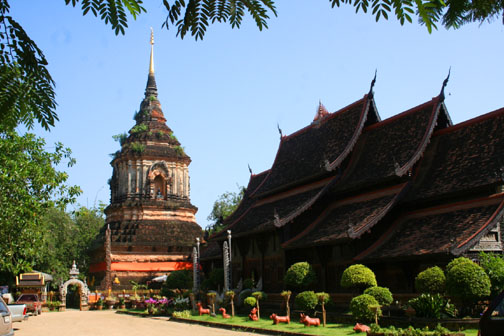

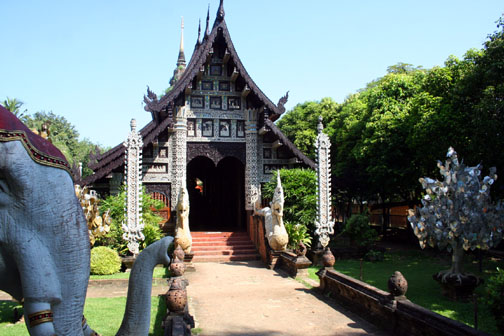


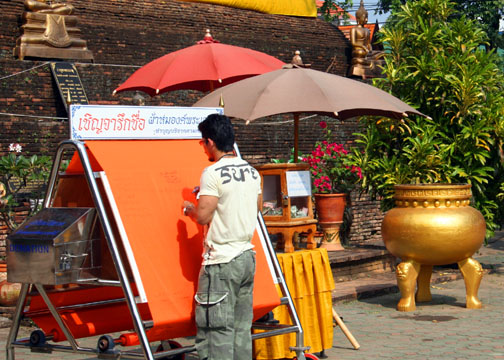


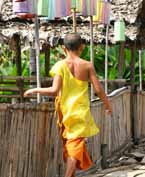

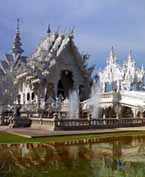
I saw the chedi at night, I will go again during day after reading your report.
And I haven’t seen it at night, so I’ll have to return too. That must be a magnificent sight if it’s properly lit.
I really need to go back up to Chiang Mai one of these days.
Yes, you do Glenn.
🙂
I love the area, so much to do and it is a great place to chill out after a week or two in Bangkok.
greetings and thank you so much for your thoughtful explanation of Wat Molee which i just visited utterly by accident today as part of my ride around the old Chiang Mai City wall…and i was SO curious about it after my visit that i jumped on line to learn more! I was surprised by this wat in so many ways, and i’ve visited a # of them here in the City, tho not for a long time! And i had never visited this one! Having spent a lot of time in India i was so surprised by all the Indian statues, Ganesha everywhere, the snakes near the cultural center with a Vishnu-esque symbol on the back of one of their heads, the lingham in the elephant garden where i found the big dancing Ganesha! And also there i found a big old wood carving of an elephant but not the trio you show here in your photo. I’ll need to go back! And there was the trimurti statue…never have i seen so many Hindu statues at a Buddhist wat! I spent 1.5 hours there despite being hungry and thirsty…just couldn’t leave…something to look at in every corner. And b/c it was a Sunday it was paricularly active including some sort of puppet that is transported up to the Buddha sitting high up in the Chedi, by a conveyor belt like string and then brought back down!?? wow…a very wonderful experience…
Thanks for your comment Liza.
Wat Molee is one of my favorites in Chiang Mai too. So much to see!
If you go back again, check out the small Ganesha shrine across the soi out back too (it’s behind the gas station on the corner).
India and Hinduism had a big effect on Thai culture back in the day. Many of those beliefs preceded Buddhism in the Kingdom, so that’s why you see so many Hindu-related statues in Thailand (as well as Cambodia).
Sounds like you had a great visit – and running across an unplanned for temple festivity is always a nice surprise!